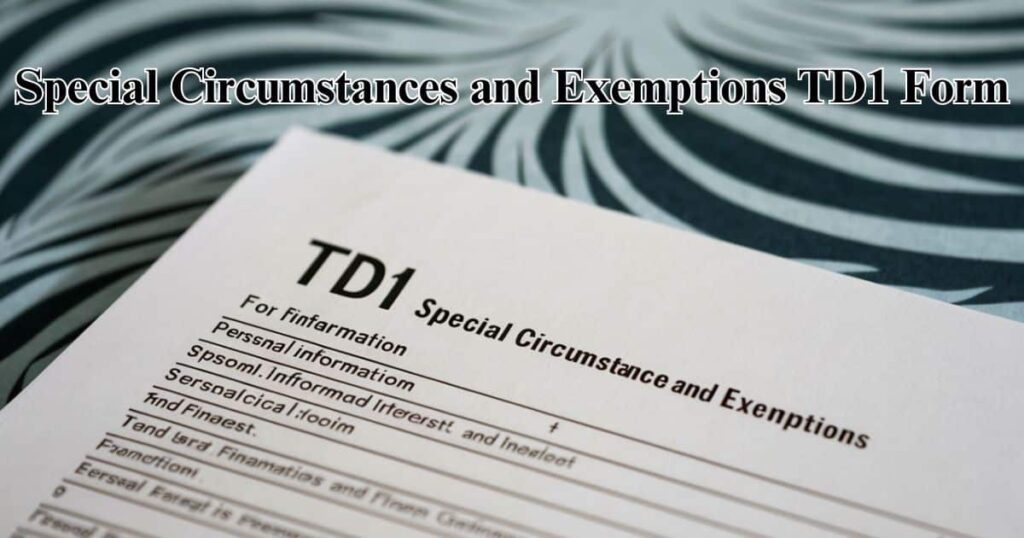Filing taxes can be daunting, but two crucial forms, the TD1 and TD1BC, play a vital role in determining your tax deductions.
The TD1 form provides information about your personal tax situation, including applicable credits and deductions, helping employers calculate the correct amount of tax to deduct from your pay.
The TD1BC form allows British Columbia residents to claim additional provincial tax credits and deductions. Accurately completing these forms ensures you don’t overpay or underpay taxes throughout the year, making it essential to understand the process.
Introduction to TD1 and TD1BC Forms
The TD1 form, officially known as the “Personal Tax Credits Return,” is a document that all employees in Canada must complete for their employers. It provides information about the individual’s personal tax situation, including any applicable tax credits and deductions. This form helps employers calculate the correct amount of tax to be deducted from an employee’s pay.
The TD1BC form, on the other hand, is specific to residents of British Columbia. It allows individuals to claim additional provincial tax credits and deductions that are unique to BC. By accurately completing this form, you can ensure that the appropriate amount of provincial tax is deducted from your income.
Understanding and properly filling out these forms is crucial, as it can impact your tax situation and potential refund or amount owed. This guide will provide you with the knowledge and tools necessary to navigate the process with confidence.
Understanding TD1 and TD1BC Forms
Purpose of TD1 and TD1BC
The primary purpose of the TD1 and TD1BC forms is to determine the appropriate amount of tax to be deducted from your income. By providing accurate information about your personal tax situation, including any eligible credits and deductions, these forms help ensure that you don’t overpay or underpay your taxes throughout the year.
Who Needs to Fill Out the Forms
All employees in Canada, regardless of their employment status (full-time, part-time, or contract), are required to complete the TD1 form. If you are a resident of British Columbia, you will also need to fill out the TD1BC form to claim any applicable provincial tax credits and deductions.
Preparing to Fill Out TD1 and TD1BC Forms

Gathering Required Information
Before you begin filling out the TD1 and TD1BC forms, it’s essential to gather all the necessary information and documents. This includes:
- Your Social Insurance Number (SIN)
- Details of any income sources (employment, investments, pensions, etc.)
- Information about your spouse or common-law partner (if applicable)
- Details of any dependents (children, disabled dependents, etc.)
- Records of any eligible tax credits or deductions (e.g., tuition fees, medical expenses)
Having this information readily available will make the process of completing the forms much smoother and more accurate.
Understanding Tax Credits
Tax credits play a crucial role in reducing your taxable income, which ultimately impacts the amount of tax you owe. Some common tax credits include:
- Basic Personal Amount
- Spouse or Common-law Partner Amount
- Age Amount (for individuals aged 65 or older)
- Canada Caregiver Amount (for individuals supporting certain relatives)
- Disability Amount
It’s important to understand the various tax credits available and determine which ones you’re eligible for, as they can significantly reduce your tax liability.
Step-by-Step Guide to Completing TD1 Form
Personal Tax Credits Return
The “Personal Tax Credits Return” section of the TD1 form is where you’ll provide information about your personal tax situation, including any applicable credits and deductions. Here’s a breakdown of the key sections:
- Basic Personal Amount: This is a non-refundable tax credit available to all individuals. The amount varies based on your annual income.
- Spouse or Common-law Partner Amount: If you’re married or in a common-law relationship, you may be eligible to claim an additional credit for your spouse or partner.
- Age Amount: Individuals aged 65 or older can claim an additional age amount.
- Canada Caregiver Amount: If you’re supporting certain relatives (spouse, common-law partner, dependent child, etc.), you may be eligible for this credit.
- Disability Amount: Individuals with a qualifying disability can claim this credit, which can also be transferred to a spouse or common-law partner in certain circumstances.
- Tuition and Education Amounts: If you’re a student or supporting a student, you may be eligible to claim these credits for tuition fees and educational expenses.
- Additional Deductions: This section allows you to claim any additional deductions, such as contributions to a registered retirement savings plan (RRSP) or union dues.
Claiming Personal Amounts
In addition to the tax credits listed above, you’ll also need to indicate any personal amounts you’re claiming on the TD1 form. These amounts can further reduce your taxable income and include:
- Interest paid on student loans
- Pension income amounts
- Split-pension amounts
- Other employment income amounts
Be sure to carefully review these sections and claim any amounts you’re eligible for.
Declaration of Conditions
The final section of the TD1 form is the “Declaration of Conditions.” Here, you’ll need to indicate if any of the following conditions apply to you:
- You have more than one employer or payer at the same time.
- You are a non-resident of Canada.
- You are an employee of the International Development Association or another international organization.
It’s essential to accurately declare any applicable conditions, as they may impact your tax situation.
Read More About: How to File a GST/HST Return in Canada: The Ultimate Guide
Step-by-Step Guide to Completing TD1BC Form
If you’re a resident of British Columbia, you’ll also need to complete the TD1BC form to claim any applicable provincial tax credits and deductions.
British Columbia Tax Credits
The TD1BC form allows you to claim various provincial tax credits, including:
- BC Basic Personal Amount: Similar to the federal basic personal amount, this credit is available to all BC residents.
- BC Age Amount: This credit is available to individuals aged 65 or older.
- BC Spouse or Common-law Partner Amount: If you’re married or in a common-law relationship, you may be eligible for this credit.
- BC Caregiver Amount: Individuals supporting certain relatives may claim this credit.
- BC Disability Amount: This credit is available to individuals with a qualifying disability.
Be sure to carefully review each section and claim any credits you’re eligible for.
Calculating Additional Credits
In addition to the credits listed above, the TD1BC form also allows you to calculate additional provincial tax credits and deductions. These may include:
- CPP/QPP contributions
- Employment Insurance premiums
- Provincial parental insurance plan premiums
- Charitable donations
It’s important to accurately calculate these additional credits, as they can further reduce your provincial tax liability.
Special Circumstances and Exemptions

Reduced Deduction at Source
In certain situations, you may be eligible for a reduced deduction at source, which means less tax will be deducted from your pay. This can apply if:
- You have multiple sources of income and your overall tax liability is lower than the deductions being made by your employer(s).
- You expect to owe significantly less tax than the amount being deducted based on your personal circumstances.
To request a reduced deduction at source, you’ll need to complete the appropriate section on the TD1 form and provide supporting documentation.
Claiming Deductions for Dependents
If you’re supporting dependents, such as children or disabled individuals, you may be eligible to claim additional deductions on your TD1 and TD1BC forms. These deductions can include:
- Canada Caregiver Amount for Other Infirm Dependents Age 18 or Older
- Eligible Dependant Amount
- Child Care Expenses
Be sure to carefully review the criteria for each deduction and provide the necessary documentation to support your claims.
Finalizing and Submitting the Forms
Double-Checking Form Entries
Before submitting your completed TD1 and TD1BC forms, it’s crucial to carefully review all the information you’ve provided to ensure accuracy. Double-check your calculations, personal details, and any claimed credits or deductions.
Errors or omissions on these forms can lead to incorrect tax deductions, resulting in potential overpayment or underpayment of taxes throughout the year. Taking the time to review and verify your entries can save you from potential headaches and complications later on.
Submitting Forms to Employer
Once you’ve completed and reviewed your TD1 and TD1BC forms, you’ll need to submit them to your employer(s). Most employers will require these forms to be completed and submitted when you start a new job or at the beginning of each tax year.
It’s important to follow any specific instructions or deadlines provided by your employer regarding the submission of these forms. Failure to submit them in a timely manner could result in incorrect tax deductions from your pay.
Post-Submission Steps
Keeping Copies of Forms
After submitting your TD1 and TD1BC forms to your employer, it’s wise to keep copies for your own records. These forms contain important information about your tax situation, and having them on hand can be helpful for future reference or in case any issues or discrepancies arise.
You can choose to keep physical copies or digital versions of the forms, whichever is more convenient for you. Just make sure to store them in a safe and secure location for easy access when needed.
Read More About; GST/HST Rates in Canada and Provincial Sales Tax Rates – An In-Depth Guide
Updating Forms for New Circumstances
Your personal and financial circumstances can change throughout the year, which may impact the information you provided on your TD1 and TD1BC forms. It’s important to keep track of any significant changes and update your forms accordingly.
Some situations that may require updating your forms include:
- Changes in marital status: If you get married, divorced, or enter into a common-law partnership, you’ll need to update your marital status and potentially adjust any claimed credits or deductions.
- Birth or adoption of a child: Having a new child can affect your eligibility for various tax credits and deductions, such as the Canada Caregiver Amount or Child Care Expenses.
- Changes in income sources: If you start a new job, lose a job, or have changes in your investment or pension income, you’ll need to update your forms to reflect your new income sources.
- Changes in residence: Moving to a different province or territory may affect your eligibility for certain provincial tax credits or deductions.
It’s important to keep your TD1 and TD1BC forms up-to-date to ensure accurate tax deductions throughout the year. Most employers will provide guidance on how to update these forms as your circumstances change.
Frequently Asked Questions
Q: Can I claim the same credits and deductions on both forms?
A: No, the TD1 form covers federal tax credits and deductions, while the TD1BC form is specific to provincial credits and deductions for residents of British Columbia. Be sure to claim the appropriate credits and deductions on each form.
Q: What happens if I don’t fill out these forms?
A: If you don’t complete the TD1 and TD1BC forms, your employer will likely deduct tax based on the highest tax rate, which means you may end up overpaying taxes throughout the year. Filling out these forms accurately ensures that the correct amount of tax is deducted from your pay.
Q: Can I update my forms midway through the year?
A: Yes, you can update your TD1 and TD1BC forms at any time during the year if your circumstances change. It’s important to keep these forms up-to-date to ensure accurate tax deductions.
Q: Do I need to submit new forms every year?
A: It’s generally a good practice to submit new TD1 and TD1BC forms at the beginning of each tax year, even if your circumstances haven’t changed. This ensures that your employer has the most current information on file.
Final Words Thoughts
Filing taxes can be daunting, but two crucial forms, the TD1 and TD1BC, play a vital role in determining your tax deductions.
The TD1 form provides information about your personal tax situation, including applicable credits and deductions, helping employers calculate the correct amount of tax to deduct from your pay.
The TD1BC form allows British Columbia residents to claim additional provincial tax credits and deductions. Accurately completing these forms ensures you don’t overpay or underpay taxes throughout the year, making it essential to understand the process.

Howdy, editor at FinanceEon.com, brings over a decade of financial journalism experience. He ensures accuracy and insightful analysis, guiding a team on market trends and investment strategies.







